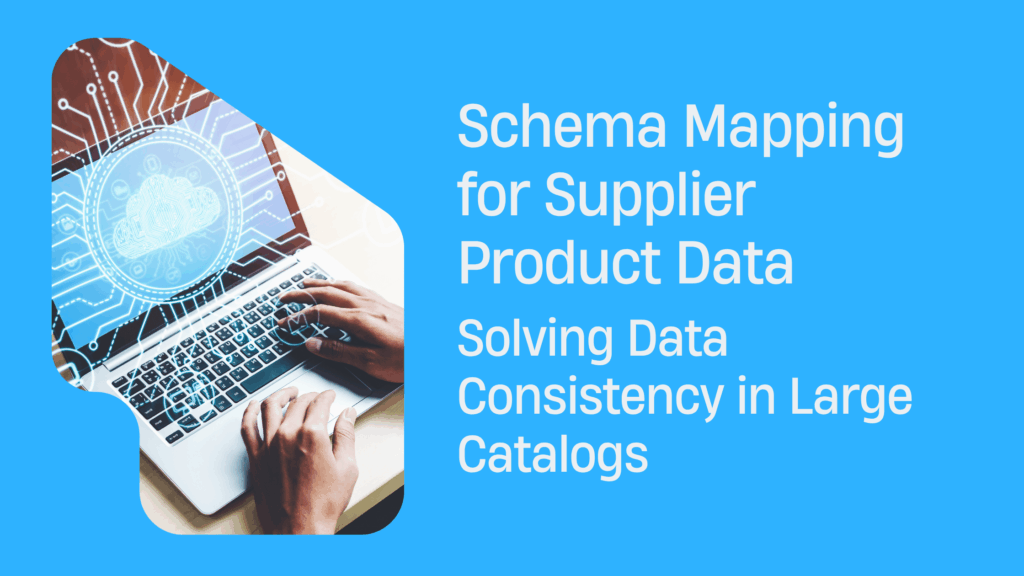Schema Mapping for Supplier Product Data—Solving Data Consistency in Large Catalogs
In ecommerce, managing large product catalogs from multiple suppliers creates challenges in data consistency. Each supplier may use a different product schema or category schema, leading to mismatches across product listings.
Schema Mapping addresses this issue by aligning diverse data formats into a unified structure. Without proper schema mapping, retailers face inaccurate product information, duplicate entries, and poor customer experience. As catalogs grow, manual mapping becomes impractical.
Automating schema mapping is crucial for maintaining clean and organized data. This blog explores the schema mapping problem in ecommerce and how structured solutions can support large-scale supplier integrations and accurate catalog management.
Challenges of Managing Multi-Supplier Data
Managing data from multiple suppliers is complex due to varying formats, categories, and attributes. Without standardization, maintaining clean, consistent product data across a large catalog becomes time-consuming and error-prone.
Data Inconsistency
Data inconsistency is a core issue in multi-supplier catalogs. Different suppliers use different structures, attribute names, and formats, which disrupts search, filtering, and overall catalog accuracy.
- Inconsistent Attribute Naming – Suppliers often use different names for the same attribute. One may list “Color,” another “Colour,” and a third “Shade.” Without Schema Mapping, this leads to fragmented or missing filter options.
- Varying Category Structures – Product category structures differ across suppliers. A “Bluetooth Speaker” may fall under “Electronics” for one supplier and “Audio Devices” for another. A unified category schema is critical for catalog consistency.
- Mismatched Attribute Values – Even when attributes match, their values may differ. For example, one supplier might use “XL” while another uses “Extra Large.” Schema Mapping helps normalize these values to a single standard.
- Non-Standard Units and Formats – Measurement units like inches, cm, lbs, or product formats like “5-inch” vs. “5in” cause confusion. Without normalization, search functions and filters become unreliable across the catalog.
- Redundant or Missing Fields – Some suppliers provide more data than others. One might list “Material Type” while another omits it entirely. Schema Mapping enables mapping missing or extra data fields into a common product schema.
These inconsistencies affect search, filters, product recommendations, and backend operations. Schema Mapping brings all this under a standardized structure for better data governance.
Attribute Mismatches
When aggregating data from multiple suppliers, inconsistencies in product attributes often lead to major catalog issues. Schema Mapping helps align these mismatches, but several technical challenges persist.
- Different Naming Conventions – Suppliers may use varying attribute names for the same information. One might use “Color,” while another labels it “Shade” or “Product Color.” Without Schema Mapping, these discrepancies result in misclassification or redundant fields in your product schema.
- Inconsistent Value Formats – Even when attribute names match, the value formats can differ. For example, size may be listed as “Medium” by one supplier and “M” by another. Standardizing these values requires a clean category schema and automated normalization rules.
- Unit Mismatches – Suppliers often use different measurement units. A product’s weight might appear as “1.5 kg” from one source and “3.3 lbs” from another. Without proper conversion logic tied to Schema Mapping, these differences can confuse listings and fulfillment processes.
- Optional vs. Required Attributes – Some suppliers may omit fields that are essential for certain marketplaces or internal systems. For instance, one may skip “Material Type,” causing gaps in search filters or category mapping. Schema Mapping tools must identify and fill these gaps with defaults or enrichment logic.
- Overlapping Attributes with Different Contexts – A shared attribute like “Finish” may mean color in furniture or texture in hardware. Schema Mapping must align context-aware attributes within the product schema to prevent cross-category data errors.
- Attribute Granularity Differences – One supplier may offer detailed breakdowns like “Screen Size (inches)” and “Resolution,” while another provides just “Display.” Merging these requires schema logic to retain data depth without creating bloated or fragmented structures.
Defining a Master Schema
Establishing standards for canonical data models is critical in schema mapping. It ensures consistency across supplier feeds, helping unify product schema and category schema in large, multi-source catalogs.
Standards for Canonical Data Models
Canonical data models provide a unified structure for incoming supplier product data. In Schema Mapping, they serve as the foundation for consistent integration and normalization.
Here are key standards to follow:
- Define Core Product Attributes Clearly – Start with a set of required attributes such as title, SKU, description, brand, category, and price. Every product must include these fields, regardless of supplier format.
- Use Controlled Vocabularies – Apply standard terminology for fields like color, size, material, and condition. This eliminates ambiguity and improves category schema alignment across suppliers.
- Normalize Unit of Measure (UOM) – Ensure consistency in UOM for dimensions, weight, and quantities. Convert all inputs to a common standard (e.g., inches, pounds) at the schema level.
- Standardize Category Schema Hierarchies – Use a predefined taxonomy for categories and subcategories. Map supplier categories to this structure to maintain consistency in product classification.
- Include Data Type Definitions – Define specific data types for each field—string, integer, boolean, date, etc. This helps enforce validation rules and prevents schema mismatch issues during ingestion.
- Define Optional vs Required Fields – Separate mandatory fields from optional ones. Required fields should be non-nullable to ensure data integrity.
- Enable Schema Version Control – Maintain versioning for the master schema to track changes. This allows backward compatibility and smoother integration of new supplier data feeds.
- Support Localization and Multilingual Fields – For international catalogs, allow fields like product name and description to accept multiple languages under locale-specific keys.
- Use Flattened Structures Where Possible – Flatten nested attributes to reduce complexity. For instance, instead of a nested “specifications” object, split specs into clearly defined flat fields.
- Automate Mapping Rules and Validation – Use tools to automate mapping from supplier fields to canonical fields. Validate incoming data against the master schema to flag inconsistencies early.
Standardizing canonical models enhances scalability, reduces manual corrections, and improves data quality across large catalogs.
Mapping Techniques
Effective Schema Mapping requires precise alignment between supplier data and your internal product schema. Choosing between manual and automated mapping methods impacts accuracy, scalability, and speed across large catalogs.
Manual vs Automated Mapping
Choosing between manual and automated mapping determines how efficiently your system handles data from multiple suppliers. Each approach has distinct strengths and limitations depending on scale, complexity, and update frequency.
| Aspect | Manual Mapping | Automated Mapping |
| Definition | Human-led process of aligning supplier fields to your product schema or category schema. | System-driven matching using algorithms, rules, or AI to align data fields. |
| Accuracy | High if done by experienced users; prone to human error in large volumes. | Consistent accuracy with well-trained logic; less prone to fatigue or oversight. |
| Scalability | Not suitable for large catalogs or frequent updates. | Easily handles large, multi-supplier catalogs and frequent changes. |
| Time Efficiency | Time-consuming and labor-intensive. | Significantly faster, especially with recurring or similar schema patterns. |
| Customization | Highly flexible; users can apply domain expertise manually. | Limited to the configuration of rules, templates, or AI model capabilities. |
| Resource Requirement | Requires skilled staff for product schema alignment. | Requires technical setup but minimal ongoing human involvement. |
| Consistency | May vary between team members and sessions. | Uniform application of schema mapping rules across all data sources. |
| Error Handling | Errors must be found and fixed manually. | Automated systems can flag mismatches and suggest corrections. |
| Learning Curve | Relatively straightforward for small catalogs. | Initial setup may require technical knowledge or integration with mapping platforms. |
| Best Use Case | Low-volume, high-accuracy environments with frequent manual oversight. | High-volume catalogs with multiple suppliers and frequent data refreshes. |
Use of AI and Fuzzy Logic
AI and fuzzy logic are increasingly used to enhance Schema Mapping accuracy, especially when dealing with inconsistent or incomplete supplier product data across large product schema and category schema catalogs.
- AI-Based Pattern Recognition – AI algorithms can recognize naming patterns, value formats, and attribute groupings within supplier feeds. This helps align inconsistent product schema fields with a centralized structure, even when naming conventions vary.
- Natural Language Processing (NLP) – NLP models interpret textual attribute names and descriptions, mapping them to standardized fields across the category schema. This supports better handling of synonyms, abbreviations, or non-standard supplier terminology.
- Fuzzy Matching for Inexact Data – Fuzzy logic enables comparison between similar but not identical data points. For example, “prod color” and “product_colour” can be detected as equivalent through fuzzy string matching, improving schema alignment.
- Confidence Scoring – AI systems can assign confidence scores to each suggested mapping. This allows data teams to verify high-risk fields and automate high-confidence matches, balancing speed with control.
- Ontology and Taxonomy Integration – AI models can reference pre-built taxonomies (e.g., for electronics or apparel) to intelligently map category schema fields by context, reducing manual configuration.
- Handling Multi-Language Data – AI translation and fuzzy logic together support cross-language product schema mapping, especially important for global suppliers with multilingual catalogs.
- Dynamic Schema Updates – AI-powered Schema Mapping can adapt to changes in supplier data feeds. New attributes or renamed fields are identified and mapped with minimal manual intervention.
- Error Detection and Correction – AI detects mismatched types or anomalies, such as mapping numeric values to text fields, and suggests corrective mapping rules based on previous logic.
Transformation & Validation
AI-powered transformation and validation ensure incoming supplier data aligns with the target schema. Techniques like fuzzy logic help match inconsistent attributes, reducing manual corrections and improving catalog accuracy.
Data Normalization Best Practices
- Standardize Attribute Names and Formats – Ensure all product attributes (e.g., “Color,” “Colour,” “clr”) are consistently named. Use a centralized naming convention to streamline schema mapping and reduce redundancy across your product schema.
- Unify Measurement Units – Convert all units (e.g., inches to centimeters, pounds to kilograms) to a standard format. This eliminates confusion when normalizing size, weight, and dimension fields in your category schema.
- Apply Controlled Vocabularies – Use predefined values for attributes like “Material,” “Condition,” or “Gender.” Limit inputs to allowed terms (e.g., “New,” “Used,” “Refurbished”) to maintain data integrity across suppliers.
- Normalize Category Taxonomy – Map supplier product categories to your internal category schema. Aligning mismatched taxonomies ensures accurate product placement and improves filtering, searchability, and reporting.
- Clean and Deduplicate Values – Remove special characters, trailing spaces, and duplicates. Standardize values like “100% cotton” vs “Cotton 100%” to maintain consistency in product listings and facilitate smoother schema mapping.
- Use Data Validation Rules – Apply validation scripts or logic (e.g., regex patterns) to ensure fields follow expected structures, such as email formats, UPCs, or SKU patterns. This reduces downstream integration errors.
- Leverage Templates for Repeat Vendors – Build and reuse normalization templates for vendors with similar product structures. It saves time and reduces manual adjustments during onboarding.
- Document Normalization Guidelines – Maintain clear documentation for your team. Include accepted formats, naming conventions, and normalization logic to ensure uniformity in ongoing and future supplier data integrations.
- Automate Where Possible – Use data transformation tools or schema mapping software to automate repetitive normalization tasks. This increases accuracy and scalability for large product catalogs.
- Audit Regularly – Periodically review normalized data for gaps, inconsistencies, or outdated patterns. Continuous auditing maintains long-term consistency across your product schema.
Automation Tools & Platforms
Automation tools and platforms simplify schema mapping across large supplier catalogs. They help ensure consistency, accuracy, and speed when aligning different product schema and category schema at scale.
Solutions Supporting Scalable Mapping
Scalable schema mapping solutions allow retailers to manage growing product catalogs efficiently. These tools reduce manual effort, maintain data accuracy, and enable consistent mapping across multiple suppliers and systems.
- AI-Based Schema Recognition – Many platforms use machine learning to recognize patterns in supplier data and auto-map fields to a master product schema. This reduces manual input and improves accuracy across large catalogs.
- Flexible Field Matching Rules – Scalable tools support custom field-matching logic, allowing users to define how supplier attributes map to internal categories or product fields. This flexibility is essential for diverse supplier formats.
- Dynamic Category Schema Alignment – Tools like PIM systems can align incoming data with a pre-defined category schema. These platforms auto-sort products into appropriate categories based on rules, metadata, and historical mapping.
- Real-Time Mapping Updates – When schema definitions evolve—such as new product attributes or updated categories—modern tools automatically detect and prompt updates across mapped data, ensuring consistency in real time.
- Bulk Import and Field Normalization – Scalable solutions support bulk data ingestion and field standardization, converting variations in units, naming, and attribute structure into uniform schema elements across the board.
- Version Control and Rollback Options – Schema mapping platforms often offer version tracking. Users can view mapping history, compare changes, and revert to previous versions, which is crucial for managing large-scale catalogs.
- Integration with Supplier Feeds – Robust platforms directly integrate with supplier feeds (CSV, XML, API) and continuously sync updated data with a mapped schema. This supports seamless automation in multi-supplier environments.
- Centralized Mapping Dashboards – Most tools provide a centralized interface where users can manage, monitor, and adjust mapping rules. This simplifies oversight for teams managing schema mapping at scale.
- Validation and Error Handling – Advanced platforms offer automated validation to catch mismatches, missing fields, or misaligned data types before schema updates go live. These checks preserve data integrity.
- Support for Multichannel Output – Once the schema is mapped, scalable tools can format product data for various channels (e.g., marketplaces, ecommerce platforms), preserving the integrity of product schema in every export.
Monitoring & Continuous Improvement
Implement Real-Time Validation and Error Logging
Use automated validation checks to monitor incoming supplier data for inconsistencies or mismatches against your defined schema. Set up error logging systems that flag structural issues, missing fields, or misaligned category schema. This enables fast detection and correction without halting operations.
Track Mapping Accuracy Metrics Over Time
Establish KPIs such as successful mapping rates, data transformation accuracy, and manual override frequency. Analyze these metrics to assess how well your current schema mapping logic is performing. Use the data to pinpoint underperforming supplier feeds or schema misalignments.
Audit Category Schema Updates Regularly
Category structures evolve—especially in large, multi-category catalogs. Review and update your category schema to reflect changes in supplier taxonomies or catalog expansions. Automate detection of newly introduced or deprecated categories to reduce manual tracking.
Schedule Periodic Schema Reconciliation
Even with automation, schema drift can occur over time. Schedule routine schema reconciliation to ensure your internal schema still aligns with supplier formats. Use version control on schema definitions to track changes and roll back if needed.
Incorporate Feedback Loops from Downstream Systems
Monitor errors or gaps reported by inventory, pricing, and merchandising systems that rely on schema-mapped data. Use this feedback to adjust your schema logic or source mappings. This ensures consistency across systems and helps maintain clean, standardized product data pipelines.
Conclusion
Schema mapping is essential for harmonizing supplier product data with internal data structures. It standardizes varied product schemas into a consistent format, enabling uniformity across large catalogs.
Accurate mapping of attributes and category schema minimizes data discrepancies, accelerates supplier onboarding, and enhances catalog precision. As product catalogs scale, maintaining data integrity becomes increasingly complex, highlighting the need for automated schema mapping.
For organizations handling data from multiple suppliers, a well-defined mapping strategy simplifies data processing and improves cross-channel product consistency. Robust schema mapping ensures cleaner data pipelines and lays the groundwork for scalable, efficient product data management.



